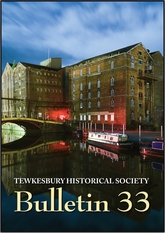Tewkesbury's Name
The name Theoc has been appropriated in different ways in Tewkesbury. As usual popular usage may mask the reality (Editor)
The origin of Tewkesbury’s place name has been the subject of much discussion and much confusion. This is largely due to a single quote in the Itinerary of John Leland who was appointed the ‘King’s Antiquary’ by Henry VIII. Between around 1535 and 1543 Leland travelled throughout England collecting material of historical interest, and visited Tewkesbury Abbey shortly before its dissolution in 1540. Here in the abbey’s library he recorded ‘A Little Book on the History of Tewkesbury Monastery’ (Libello de Antiquitate Theokesbiriensis Monasterii).[1] Whilst the original manuscript is now lost, Leland’s notes included a direct quote about a Christian hermit named ‘Theoc’ after whom the town was supposedly named:
“Theocus Heremita mansiunculam habuit prope Sabrinam unde et Thokesbyria.”
“Theoc the hermit held a house near the Severn and whence Tewkesbury.”
Unfortunately this story does not stand up to closer scrutiny. The earliest direct reference to the town’s name is found in the Domesday Book of 1086, commissioned by William I to assess his new kingdom, where it appears as Teodechesberie and Teodekesberie.[2] This name consists of two elements, the personal name Teodec and the Old English word burh meaning ‘fortified place’ from where we get the modern English ‘borough’ and ‘bury’. Together these elements can be read as ‘Teodec’s fortified place’. An Anglo-Saxon charter of 963 AD concerning land near Aspley Heath in Warwickshire contains the similar Old English place names Teodeces-leage ‘Teodec’s clearing’ and Teodeces-broc ‘Teodec’s brook’.[3] These examples lend further weight to the Domesday Book spelling of Tewkesbury, and would suggest that Teodec was the Anglo-Saxon lord after whom the settlement was named.
The name Theoc, on the other hand, does not contain the middle consonant ‘d’ and appears to have been taken from the later medieval spelling of the town’s name Theokesburie, rather than being a corruption of the earlier personal name Teodec. It was not uncommon for medieval chroniclers to invent origins for people and places if their source material was lacking such details. A similar example would be the town of Keynsham in Somerset, which according to local legend was named after the 5th century Welsh princess and Christian missionary St. Keyne (Welsh Cain), and thus said to mean ‘St. Keyne’s home’. However, the earliest reference to the town is found in the Chronicle of Æthelweard (c. 978-988 AD), where it appears as Cægineshamme meaning ‘Cægin’s water-meadow’.[4] The Old English personal name Cægin was in fact male rather than female, and is also found in 975 AD as Cægnesworðe meaning ‘Cægin’s enclosure’ now the village of Kensworth in Bedfordshire.[5] In the Domesday Book of 1086 Keynsham appears as Cainesham, and in later medieval records as Keinesham, which is when the association with St. Keyne appears to have arisen. This close parallel with the Tewkesbury story casts serious doubt on the existence of ‘Theoc the hermit’ who likewise may have been adopted or invented to explain the origin of the town’s name.
References
- Toulmin Smith L., ed. 1909, The Itinerary of John Leland, London, IV, 150.
- Morris J., ed. 1982, Domesday Book: Gloucestershire, 15, Chichester, 163 b and c.
- Sawyer, P.H., 1968, Anglo-Saxon Charters, Royal Historical Society, London, S1307.
- Campbell A., ed. 1962, The Chronicle of Æthelweard, London, IV.2, 38.
- Ekwall E., 1960, Concise Oxford Dictionary of English Place Names, Oxford.


Comments